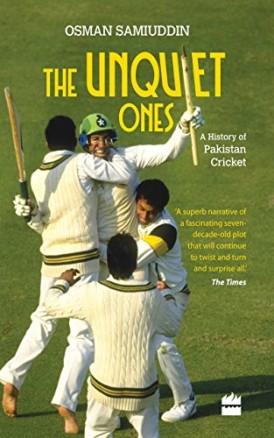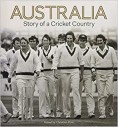The Unquiet Ones: A History of Pakistan Cricket
Jon Gemmell |Published: 2014
Pages: 510
Author: Samiuddin, Osman
Publisher: Harper Collins
Rating: 5 stars

This is as thorough and entertaining book as you will hope to find on any cricketing history, let alone one about Pakistan; the work of an artisan at the height of his powers. The volume begins at the Oval in 1952 where Pakistan became the first and only side to win a Test on their first tour to England. From there it takes us on a journey through the side’s cricketing fortunes, with an ever-present eye on the social and political setting in which the sport is played.
Inevitably, early cricket mirrored developments in India. The Parsis were amongst the first to play, a communal tournament was in place, whilst several patrons, including many political appointees, aided the sport’s progress. Cricket had developed in the club structure in Lahore and Karachi and the rivalry between the elitist Islamia and Government Colleges. These were strong enough to ensure that Pakistan won a Test on its first tour to India.
The relationship between politics and cricket is more pronounced than in any other country. Nawab Iftikhar Hussain Khan, the chief minister of Punjab, was elected the first president of the Pakistan board. Since then, managers and selectors have been largely political appointees. Ayub Khan, Zulfikar Ali Bhutto and Muhammad Zia-ul-Haq all feature for both their highhanded political presence as well as their impact on cricket.
Alongside being a chronological narrative, the book provides a number of cameos on the sport’s prominent individuals, using them as centre-pieces to tell a wider story. There are tributes to, among others, Justice Alvin Cornelius, Abdul Kardar, Mushtaq Mohammad, Aftab Gul, Hanif Mohammad, Omar Kureishi, Arif Ali Abbasi, Nur Khan, Javed Miandad, Imran Khan, Wasim Akram and Mohammad Amir. If some of these are not quite household names, it is because of their work behind the scenes rather than on the field of play.
Pakistan enjoyed an encouraging start to international life. They had won a Test in India, England, the West Indies, Australia and New Zealand by 1960, just eight years after becoming a Test nation. No other country could boast such a beginning. Things slowed in the 1960s when the side only played thirty Tests, winning just two. In the 1970s the government encouraged companies to create teams and provide players with jobs. This opened up the sport to those from the towns and poorer backgrounds.
Their victory at the 1992 World Cup brought to a close a period where Pakistan were as good as they had ever been. A key reason for this was wider diversification. Until the series against India in 1978, they had sourced the majority of Test players from two cities – Lahore and Karachi – the cultural and commercial hearts of the country. The game now started to spread beyond these two urban centres. A first ever Test was held in the industrial heartland Faisalabad in 1978. Only eight cities had contributed to the list of Pakistan-born Test players until the Indian series; after that at least 27 different locations could post a claim to have given birth to an international cricketer.
Things, though, start to unravel as we move into the 21st century. In August 2006, Pakistan became the first ever side to forfeit a Test, being accused of ball-tampering. Shoaib Akhtar and Mohammad Asif tested positively for steroids. Their coach Bob Woolmer died in a hotel room hours after the side were eliminated from the 2007 World Cup. In the 1990s Pakistan would play a match with anything from five to seven of their players under investigation for corruption. In the summer of 2010, Salman Butt, Mahammad Amir and Asif were caught accepting money for spot fixes. Finally, in March 2009, Sri Lankan cricketers were attacked in a terrorist ambush. ‘After years of dry retching, those four years felt like a period of sustained vomiting.’
A number of obstacles still get in the way of Pakistan progressing further. Material factors mean that most youngsters are brought up playing tape-ball cricket in the streets. Fundamentalist Islam holds a light to terrorist organisations ensuring that no-one wants to tour Pakistan; it has also led to complaints that under Inzamam, a member of the Tableeghi Jamaat, the side were more focused on faith than they were on the cricket. Fajr prayer calls at dawn hampered players preparations, whilst those who did not accept the cause became outcasts. The biggest obstacle, though, in financial terms, is the fallout with neighbours India. The loss of home internationals has cost Pakistan at least $100 million, a figure that shows no evident sign of slowing.
Whether the author agrees with this is unknown as the book ends suddenly with no concluding thoughts or insights into potential difficulties facing the future Pakistan. Don’t let that, though, put anyone off: this is a fine work on the history of Pakistan, it is a superb review of the nation’s leading sport. It is one of the finest books I have read on any country and worthy of being one of Wisden Cricket Monthly’s seven greatest books ever written.






Leave a comment